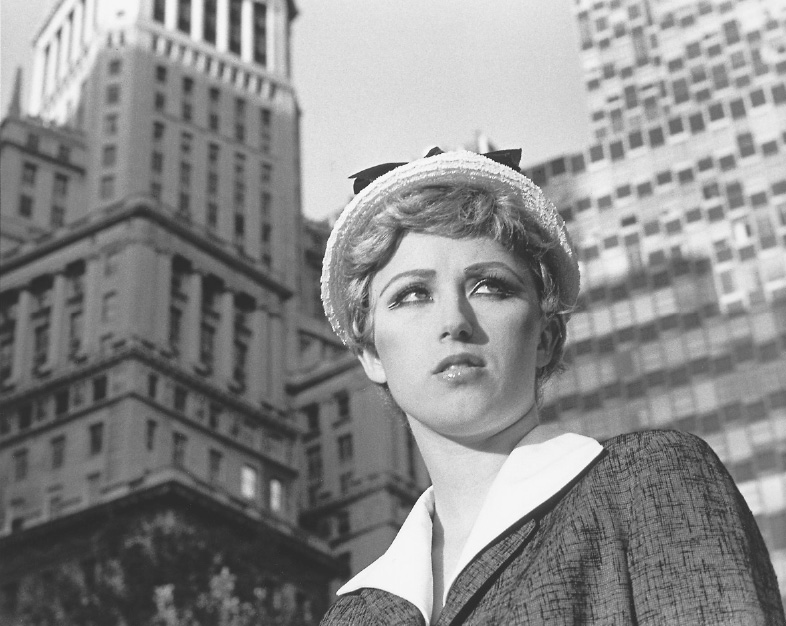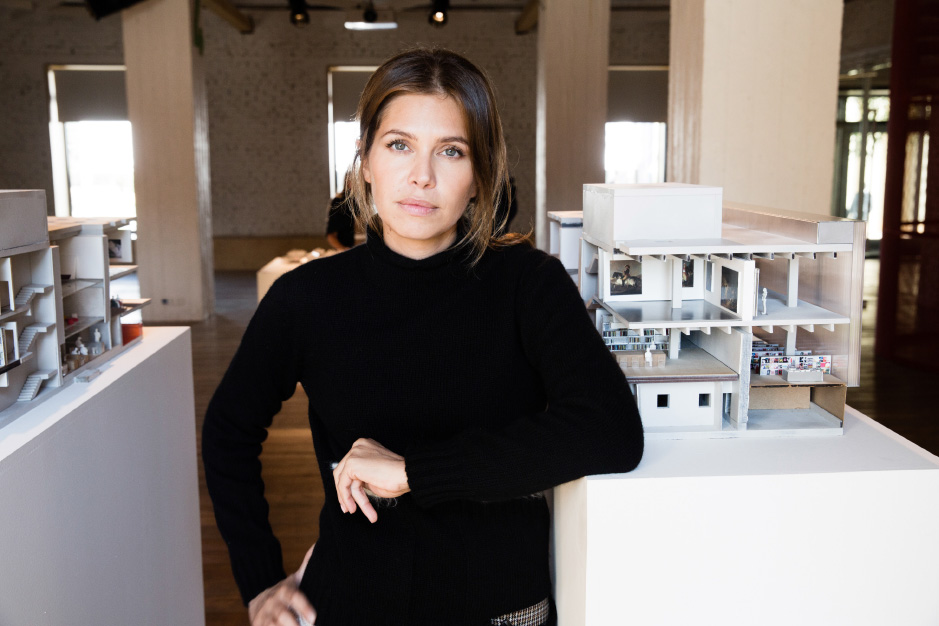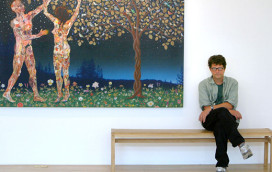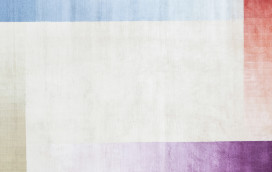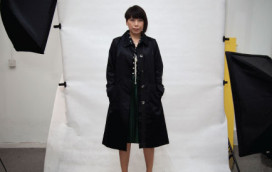On a spring evening earlier this year, a group of women gathered in a stunning apartment just seconds from London’s Kensington Palace. As the uniformed maid opened the door, it seemed as if we were being ushered into an über-exclusive cocktail party, a sensation boosted by the glamour of the guests, many of whom were dressed by the likes of Prada, Issey Miyake and Armani.
In reality, a far more interesting event was taking place. Among these women were the crème de la crème of the international art world. There was Julia Peyton-Jones, co-director of London’s Serpentine Gallery; Iwona Blazwick, who curates exhibitions for The Gallery at Windsor in Florida; our Italian hostess Valeria Napoleone, a committed collector of art by women; the artist Cornelia Parker; and Candida Gertler and Yana Peel, who set up Outset, an art fund which raises money to buy contemporary works for public collections all over the world.
The women had come to support Women for Women International, an NGO that has helped more than 400,000 women affected by war and conflict. The support here is not only a sign of how many women are willing to help to rebuild other women’s lives around the world, but of how women are becoming increasingly influential in the art world, with dozens of members keen to employ their skills, privilege and experience to help others.
Such a gathering of powerful women in art would have been impossible in 1971, when the feminist art historian Linda Nochlin wrote a seminal essay entitled, “Why Have There Been No Great Women Artists?”. Drawing attention to the lack of “women equivalents for Michelangelo or Rembrandt, Delacroix or Cézanne, Picasso or Matisse, or even in recent times, for Willem de Kooning or Warhol”, Nochlin pinpointed the social mechanisms that had kept women from the studio. Culprits included institutional sexism – men controlled the academies and women were not accepted into the Paris Salon for example, a crucial showcase for 19th-century French painters. More importantly, however, for centuries women had been primarily lauded for being mothers and castigated for traits such as creativity that were seen as masculine.
Today, the situation is different. Female artists are so ubiquitous that their presence no longer raises eyebrows. This year, for example, MoMA has hosted exhibitions devoted to Yoko Ono and Björk; Atlanta’s High Museum of Art has featured ceramicist Molly Hatch and photographer Helen Levitt; the Perez Art Museum in Miami showcased Brazil’s most expensive living artist, Beatriz Milhazes; major shows at London’s Tate Modern were devoted to Sonia Delaunay and Marlene Dumas, while the Museum of Fine Art in Houston showcased the collection of art historian Alice C. Simkins. Although still less expensive than their male counterparts, works by female artists are also selling for sky-high sums. In 2014, for example, a group of 21 black and white photographs by Cindy Sherman, Untitled Film Stills 1977-1980, sold at auction for $6,773,000. The conceptual sculptor Cady Noland’s Oozewald (1989) fetched a similar figure at Sotheby’s New York in 2011.
Across the world, female curators, gallerists and collectors are stamping art with their imprint. There are nine women in the Top 20 of Art Review’s Power List 100 for 2014. At number 13 stands Sheikha Al-Mayassa bint Hamad bin Khalifa al-Thani, chairperson of Qatar Museums, who has presided over the construction of a new cultural hub in the Gulf state. Also prominent are Beatrix Ruf, director of the Stedelijk, Amsterdam’s leading contemporary art museum; Carolyn Christov-Bakargiev, director of this year’s Istanbul Biennial and recently appointed director of two of Turin’s major institutions, the Castello di Rivoli and GAM (Civic Gallery of Modern and Contemporary Art); and Marian Goodman, New York’s most respected gallerist.
Other women to have made their mark include Dasha Zhukova, who founded the Garage Museum of Contemporary Art in Moscow (which recently reopened in a new building designed by Rem Koolhaas), and Donna De Salvo, the chief curator at the Whitney Museum of American Art in New York. To inaugurate the Whitney’s new Renzo Piano-designed home, De Salvo unveiled her show America Is Hard to See, and succeeded in putting an expression of “stupid bliss” on the face of the renowned critic Simon Schama.
The surge in women’s influence is fuelled by myriad factors. Iwona Blazwick believes the empowerment of women in culture reflects their disenchantment with the political realm in the latter part of the last century. “The really radical stuff was happening in theatre, literature, media and art,” says Blazwick. “Only later did it percolate into the wider culture.”
Opportunities for women differ from country to country. In Singapore, Emi Eu is director of the Singapore Tyler Print Institute, a non-profit organization that runs exhibitions and residencies for artists working with print-making techniques. While Singapore’s art scene is less developed than that of New York, she says, both the Singapore Art Museum and the National Museum of Singapore have female directors – Susie Lingham and Angelita Teo. This, she suggests, perhaps indicates that opportunities might occur more readily when a cultural scene is still emerging.
It is also possible that women’s strengths – their capacity for working together instead of competing, and working as a community rather than in a competitive way – make them ideal candidates for operating within arts organizations. Carolyn Christov-Bakargiev, who was director of dOCUMENTA (13), the 2012 German exhibition that was arguably contemporary art’s most radical and important showcase, believes women’s history of caring for things helps, too. “After all they have spent thousands of years managing domestic relations!”
The approach women take, it is widely agreed, is different, too, with female patrons taking a more sensitive approach. Valeria Napoleone, who has gathered around 300 works by female artists, from New York-based Tauba Auerbach to sculpture by the acclaimed Polish artist Goshka Macuga, says she believes she takes more time than many men. “I stop and think. It’s different from a competitive, rushing, speculative attitude.”
Napoleone also believes that to support artists, you have to do more than buy their work, which is why she regularly hosts dinners for leading emerging talents. “Artists need time to grow, to experiment,” she says. “They need to have the self-confidence to make mistakes. In that sense, they are like children.”
In spite of the rising prominence of women in the art world, the majority of the top jobs in the most prestigious institutions – the Metropolitan Museum of Art in New York, the Louvre in Paris, the Prado Museum in Madrid – are still held by men. “I think it has to do with tradition,” observes Emi Eu. “When the museums were set up [in 18th and 19th centuries], it was mostly men in the workforce. When women started to contribute, they took up more curatorial roles.”
Slowly, however, the situation is changing. “There was a glass ceiling,” admits Beatrix Ruf. “But in the last few years things have changed a lot. There’s a much more equal playing field. The last director of the Stedelijk was also a woman,” she points out, referring to her predecessor, Ann Goldstein. Another top museum, the Kunsthistorisches in Vienna, also boasts a female general director, Sabine Haag.
Nevertheless, there is still work to be done. Christov-Bakargiev observes that we are still living in a world where men inspire more confidence when business relationships and money are at stake. “Prejudice still exists,” she continues, before confessing that she has often asked male colleagues to accompany her to important meetings, “because that presence is comforting to the people I am meeting”.
Such challenges partly explain why women have made their biggest strides beyond the walls of institutions. A rollcall of the world’s leading private galleries would not be complete without, for example, Barbara Gladstone, who has outposts in New York and Brussels and represents the likes of Anish Kapoor and Elizabeth Peyton; Marian Goodman, who presides over spaces in Paris, New York and London and represents Gerhard Richter and Steve McQueen; and Victoria Miro, who represents Japanese artist Yayoi Kusama, the world’s most expensive living female artist. Women also shine when they choose to start their own non-profit organizations. Just consider Dasha Zhukova, or Maja Hoffmann, founder of the LUMA Foundation in Arles in the south of France, or Marina Abramovic, the legendary performance artist who has now started her own American institute.
Flexibility is another factor that attracts high-achieving women to being their own boss. “I thought it would be more manageable to be a mother and work in the private sector,” recalls the gallerist Daniella Luxembourg, who co-founded Luxembourg & Dayan in a Manhattan townhouse in 2009, and this year has shown the Korean artist Minjung Kim and figure drawings by Richard Prince.
Born in Israel, Luxembourg started out at the age of 23 as a curator at an ethnographic museum in Jerusalem, before establishing her own art empire in New York. “It was a pioneering culture in Israel,” she recalls, highlighting how important cultural attitudes are to the status of women in society. “Everything was new. The Prime Minister was a woman. Women participated in the army.”
If the women who are shaping this world have one thing in common, it’s a profound passion for art. Iwona Blazwick recalls the first show she ever saw at the Whitechapel Gallery in East London, where she is now director. “It was by Eva Hesse,” she says, naming the celebrated German-born American sculptor whose emotional brand of Minimalism revolutionized the movement. “It changed everything I knew about art,” she continues, adding that she loves her role because “the excitement of looking and learning is extraordinary. Just when you think it’s gone as far as it can go [it goes further].”
When I talk to Blazwick, she is at the inauguration of the Venice Biennal. “I’ve just seen artists from Haiti staging an opera!” she enthuses. “The ability, as a curator, to provide a platform for those kind of expressions is a huge privilege. Being an artist is a very hard path. But as a curator you can define a zeitgeist and make an impact on social change.”
For Valeria Napoleone, the discovery of artists such as Cindy Sherman and Barbara Kruger in the late 1990s proved a turning point. “Women’s art offers so much potential to contemporary culture,” she declares. “These were artists who truly spoke to me. I felt a very strong sense of connection.”
A tendency to be more empathetic than men is another reason women are so valuable as curators, gallerists and patrons. It means they are able to turn their gaze outward beyond the art world to help others, as Napoleone did when she hosted the Women for Women International event. “Women take joy in nurturing and giving,” she says. “We enjoy the journey together.”
Your address: The St. Regis Bal Harbour Resort; The St. Regis Atlanta; The St. Regis New York; The St. Regis Doha; The St. Regis Moscow Nikolskaya; The St. Regis Singapore
